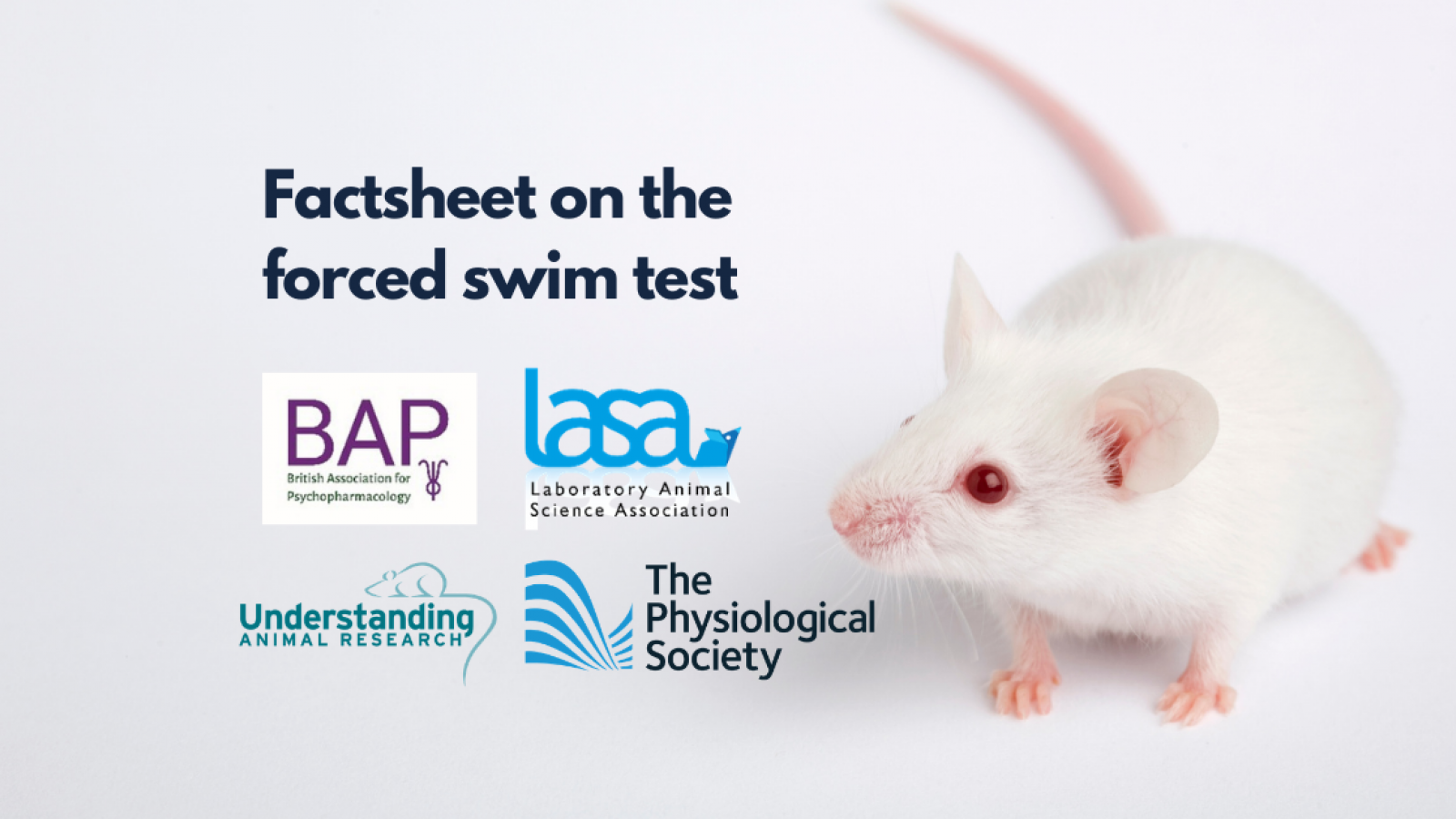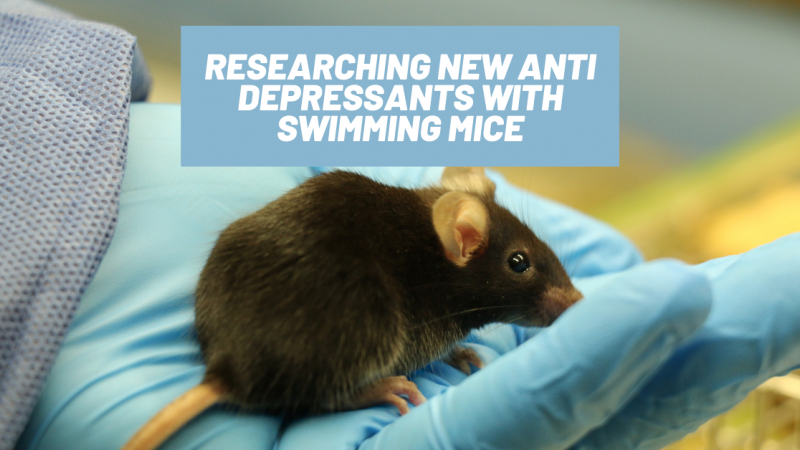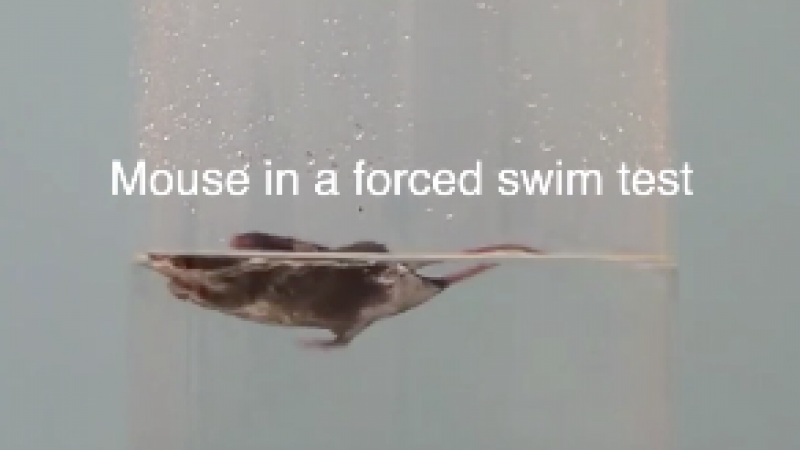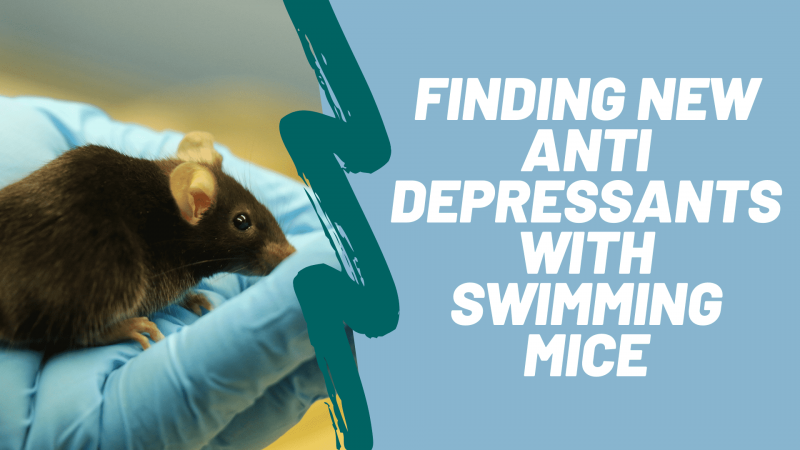Factsheet on the forced swim test
Recently, many questions have been asked about the use of the forced swim test (also known as the FST or Porsolt Swim Test) in research into antidepressants and depression. These questions relate to:
-
The validity of the test and whether the information gained from it translates into humans.
-
The severity of the test and its effects on the welfare of the animals involved.
-
Whether the benefits gained from the test justify the harms caused to the animals.
This document sets out some information about how this test is used in the UK, and answers some of the questions being raised.
What is the forced swim test?
The FST is a behavioural test which assesses the efficacy of potential antidepressant treatments. It involves putting a rat or mouse into a small tank of water, from which it cannot escape. The water is heated to between 25 and 30 degrees Centigrade to ensure that the animals do not develop hypothermia, which would affect their welfare and the findings from the test. After a few minutes of swimming around and trying to climb out of the tank, the animal stops trying to escape and instead floats in the water, moving occasionally to keep floating.
The test typically lasts around five to six minutes, after which the animal is lifted out. It is not left in the water until the point of exhaustion. Rats and mice are naturally buoyant but if at any point during the test the animal were to look as though it were struggling to stay afloat, it would be taken out of the water.
The length of time that the animal was active and then floating (‘immobile’) in the water is recorded. Additional behaviours including swimming and climbing may also be recorded. Antidepressants make stressed animals move more than they would if they had not been given an antidepressant, so if the animal has been given an antidepressant treatment prior to the test it will spend more time swimming and less time floating. Animals that have not been given an antidepressant treatment (known as ‘controls’) or animals given a treatment that does not have antidepressant properties will spend less time swimming and more time floating.
By comparing the swimming and floating times of the dosed animals and the control animals, researchers can tell whether or not a potential new antidepressant is likely to be an effective treatment in depressed patients. If a potential treatment works in these animals, it can then go on to further stages of testing.
How severe is the test? Does it harm the animals involved?
The FST is stressful to the animal – research has shown that a rat put into a tank of water experiences a similar level of stress as a wild rat encountering cold weather in winter1. For this reason, the FST is usually given a ‘moderate’ severity classification2. However, steps are taken to reduce the potential harms, such as gentle drying, and warming in a heated holding cage before returning to its home cage and cage-mates. The animal’s behaviour returns to normal almost immediately following the test and this is monitored to ensure it does not suffer any ongoing distress.
Why is the FST used? Does it work? What are its limitations?
The FST was developed as a screen for potential antidepressants since animals dosed with established antidepressants swim for longer than the control animals that have not been dosed. It is a highly effective test3 when used for this purpose and provides a gateway to clinical trials by helping to predict whether or not the test drug is likely to have any antidepressant actions at all. All existing antidepressant treatments for human beings have induced longer swimming times in animals in the FST.
Some scientists have in the past assumed that ‘giving up’ on the attempt to get out of the tank indicates that the mouse or rat feels helpless and that there is no point carrying on. Because a feeling of helplessness is common in depression, this led to the FST sometimes being used to test whether a particular animal could be considered a ‘model for depression’. However, that explanation is now controversial. It was also far too simplistic, as depression has numerous symptoms in humans, such as feelings of guilt, worthlessness, and suicidality, which cannot be evaluated in animals. It is important to acknowledge that the FST is not a model for depression and so cannot be used to investigate the cause(s) of that illness.
The FST is also unable to demonstrate how fast acting an antidepressant might be in humans, or whether it might have unwanted side-effects. Further animal and non-animal research would be necessary to examine these aspects of a potential new antidepressant before it is tested in human volunteers.
Why do we need to test for new antidepressant compounds?
We urgently need better treatments for depression. The World Health Organisation ranks depression as the leading cause of disability worldwide, affecting more than 264 million people. Suicide, which can be linked with depression, remains a major cause of death in the UK and the rate of suicide among those under 25 is increasing. Only a third of patients respond to the first antidepressant they are prescribed, and another third do not respond to any available drug treatment.
There are dozens of different antidepressant products available, as well as counselling, cognitive behavioural therapy and other ‘talking therapies’, many of which are highly effective. But research is still needed to produce better drugs for patients with severe depression.
Antidepressants (with the possible exception of the newly-licensed esketamine) have a slow onset of therapeutic action so patients do not start to feel any better for quite a while – often many weeks – and a faster onset of therapeutic effects would reduce the chances of patients coming to harm. All current antidepressants also have side-effects, which can make them inappropriate for some patients and some people cannot take certain types of antidepressants if they have pre-existing health conditions.
Are there any non-animal tests that could replace the FST?
Unfortunately, there are currently no ‘in vitro’ (non-animal) methods of checking whether a potential new treatment is likely to have antidepressant effects. At present there are no reliable biomarkers for depression so we cannot give a healthy or depressed patient a potential antidepressant and do a blood test to see if the new medicine is effective. Human tests involve giving depressed patients a potential new treatment and then waiting to see whether their depression improves. For obvious reasons, we would not want to give a depressed person- who may be suicidal - a potential new treatment (and therefore not treat them with existing treatment that is known to be an effective antidepressant) if we had no evidence that the new treatment had antidepressant properties.
Animal research, including the FST, will in some scenarios remain an important part of the process for researchers trying to determine whether a potential new treatment is likely to work as an antidepressant, at least until non-animal alternatives are developed and validated. Many, many pieces of evidence are considered before a new medicine can be prescribed by doctors for their patients and the FST is used to produce just one of those pieces of evidence.
Are other tests available that are less stressful for the animals involved?
There are currently no ‘in vitro’ (non-animal) tests that can screen compounds for antidepressant activity. There are other tests that can be used to see whether animals move more in a stressful situation if they have been given a potential antidepressant, but they all necessarily involve a stressful situation for the animal4. None of these other animal tests has been evaluated for their reliability as predictive screens for antidepressants as thoroughly as the FST, which can produce reliable results for this class of drugs when used in properly designed and controlled experiments.
Scientists are working to develop less stressful tests and it is hoped that new tests to replace the FST will be developed and validated in the future. So far, none is as reliable as the FST and so, unless this test is used, there is a high risk of producing misleading conclusions about the potential antidepressant effects of test drugs. If animals are used for less reliable tests that do not produce robust data, then the stress that the animals are put through does not result in any benefit and the animals’ lives are wasted. This is unacceptable.
I heard that the FST does not work for all antidepressants, and has worked for substances that are not antidepressants?
A wide-ranging analysis of published studies, in terms of date, research group, country of origin, species and drug classes tested (see the table below) shows that all antidepressants currently available on prescription increase swimming time in the FST, regardless of the biological target of the compound and the biochemical mechanisms involved.
There are other substances that have a similar antidepressant effect in the FST but are not currently used to treat depression in humans for various reasons (for example because of unacceptable side effects.)
Why are some scientists not using the test anymore?
While the FST is a highly effective predictive test of the antidepressant properties of a new treatment, it is now recognised that it is not a valid model of depression. So, if the question is ‘have we created an animal that is depressed?’ then the answer will be ‘no’. Over the last ten years, science has evolved, and most scientists have been moving away from using the FST as a model of depression as this interpretation is not justified. However, the FST is still widely used for screening potential antidepressants in order to identify compounds that should be investigated further.
The authors are grateful to members of the Animal Science Group of the Royal Society of Biology, the British Pharmacological Society, and individuals from across the bioscientific sector for their help and discussion in drafting this document.
This factsheet can be downloaded as a PDF listing a literature review of FST as predictive test for antidepressants and all references here: Forced Swim Test fact sheet.pdf
For more information on how the forced swim test is being used to develop new antidepressant drugs, please read our article, Researching new antidepressants with swimming mice.
References
1. Benedict CR, Fillenz M Stanford SC (1979) Noradrenaline release in rats during prolonged cold stress or repeated swim stress. Br J Pharmacol. 66: 521-524.
2. David Smith, David Anderson, Anne-Dominique Degryse, Carla Bol, Ana Criado, Alessia Ferrara, Nuno Henrique Franco, Istvan Gyertyan, Jose M Orellana, Grete Ostergaard, Orsolya Varga and Hanna-Marja Voipio (2018) Classification and reporting of severity experienced by animals used in scientific procedures: FELASA/ECLAM/ESLAV Working Group report. Lab Anim. 52(1 Suppl): 5–57.
3. Benoit Petit-Demouliere, Franck Chenu, Michel Bourin (2005) Forced swimming test in mice: a review of antidepressant activity Psychopharmacology (Berl) 177(3):245-55.
4. Carla Gambaranaa, Simona Scheggia, Alessandro Tagliamontea, Pierluigi Tolua, Maria Graziella De Montis (2001) Animal models for the study of antidepressant activity Brain Research Protocols 7, 11–20
Last edited: 28 October 2022 15:03




